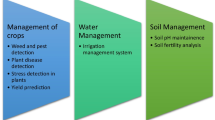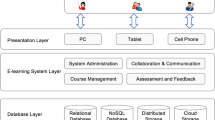Abstract
Develo** plant identification skills is an important part of the curriculum of any botany course in higher education. Frequent practice with dried and fresh plants is necessary to recognize the diversity of forms, states, and details that a species can present. We have developed a web-based assessment system for mobile devices that is able to pose appropriate questions according to the location of the student. A student’s location can be obtained using the device position or by scanning a QR code attached to a dried plant sheet in a herbarium or to a fresh plant in an arboretum. The assessment questions are complemented with elaborated feedback that, according to the students’ responses, provides indications of possible mistakes and correct answers. Three experiments were designed to measure the effectiveness of the formative assessment using dried and fresh plants. Three questionnaires were used to evaluate the system performance from the students’ perspective. The results clearly indicate that formative assessment is objectively effective compared to traditional methods and that the students’ attitudes towards the system were very positive.








Similar content being viewed by others
Notes
There are several matrix codes (Kato and Tan 2007). Among them, the QR code is perhaps the most common in mobile applications, because it has an official standard (ISO 2006) and can be used freely. QR code (quick response code) is a trademark of the Japanese company Denso Wave (a Toyota subsidiary). It can encode all types of data. In particular, it can encode a string and hence a URL.
References
Anderson LW, Krathwohl DR, Bloom BS (2001) A taxonomy for learning, teaching, and assessing a revision of Bloom’s taxonomy of educational objectives. Longman, New York
Biggs JB (2011) Teaching for quality learning at university: what the student does. McGraw-Hill Education, UK
Black P, William D (2009) Develo** the theory of formative assessment. Educ Assess Eval Account 21(1):5–31
Bloom BS, Krathwohl DR, Masia BB (1956) Taxonomy of educational objectives: the classification of educational goals. D. McKay, New York
Buchanan T (2000) The efficacy of a World-Wide Web mediated formative assessment. J Comput Assist Learn 16(3):193–200
Conejo R, Guzmán E, Millán E, Trella M, Pérez-De-La-Cruz JL, Ríos A (2004) SIETTE: a web-based tool for adaptive testing. Int J Artif Intell Educ 14(1):29–61
Cooper B, Cowie B (2010) Collaborative research for assessment for learning. Teach Teach Educ 26(4):979–986
Crowe A, Dirks C, Wenderoth MP (2008) Biology in bloom: implementing Bloom’s taxonomy to enhance student learning in biology. CBE-Life Sci Educ 7(4):368–381
Dufresne R, Gerase W (2004) Assessing-to-learn: formative assessment in physics instruction. Phys Teach 42:428–433
Fabienne M, van der Kleij M, Eggen TJHM, Timmers CF, Veldkamp BP (2012) Effects of feedback in a computer-based assessment for learning. Comput Educ 58(1):263–272
Gardner J, Belland BR (2012) A conceptual framework for organizing active learning experiences in biology instruction. J Sci Educ Technol 21(4):465–475
Gikandi JW, Morrow D, Davis NE (2011) Online formative assessment in higher education: a review of the literature. Comput Educ 57(4):2333–2351
Guzman E, Conejo R, Perez de la Cruz JL (2007) Improving student performance using self-assessment tests. IEEE Intell Syst 22:46–52
Huang H-M (2002) Toward constructivism for adult learners in online environments. Br J Educ Technol 33:27–37
Huang HW, Wu CW, Chen NS (2012) The effectiveness of using procedural scaffoldings in a paper-plus-smartphone collaborative learning context. Comput Educ 59:250–259
Hwang GJ, Chang HF (2011) A formative assessment-based mobile learning approach to improving the learning attitudes and achievements of students. Comput Educ 56(4):1023–1031
ISO (2006) Information technology—automatic identification and data capture techniques—QR Code 2005 bar code symbology specification. Technical Report ISO/IEC 18004:2006 International Organization for Standardization
Jordan S (2012) Student engagement with assessment and feedback: some lessons from short-answer free-text e-assessment questions. Comput Educ 58(2):818–834
Karpicke JD, Roediger HL III (2008) The critical importance of retrieval for learning. Science 319:966–968
Kato H, Tan KT (2007) Pervasive 2D barcodes for camera phone applications. IEEE Pervasive Comput Comput Mob Ubiquitous Syst 6:76–85
Kirchoff BK, Delaney PF, Horton M, Dellinger-Johnston R (2014) Optimizing learning of scientific category knowledge in the classroom: the case of plant identification. CBE-Life Sci Educ 13(3):425–436
Klionsky DJ (2008) The quiz factor. CBE-Life Sci Educ 7(3):265–266
Laine TH, Vinni M, Sedano CI, Joy M (2010) On designing a pervasive mobile learning platform. Res Learn Technol 18(1):3–17
Law C, So S (2010) QR codes in education. J Educ Technol Dev Exchange 3:85–100
Lee SW-Y, Tsai C-C (2013) Technology-supported learning in secondary and undergraduate biological education: observations from literature review. J Sci Educ Technol 22:226–233
Lucke U, Rensing C (2014) A survey on pervasive education. Pervasive Mob Comput 14:3–16
McDaniel MA, Anderson JL, Derbish MH, Morisette N (2007) Testing the testing effect in the classroom. Eur J Cogn Psychol 19:494–513
Momsen J, Offerdahl E, Kryjevskaia M, Montplaisir L, Anderson E, Grosz N (2013) Using assessments to investigate and compare the nature of learning in undergraduate science courses. CBE-Life Sci Educ 12(2):239–249
Ohkawa C (2000) Development of teaching materials for field identification of plants & analysis of their effectiveness in science education. Am Biol Teach 62(2):113–123
Ozcelik E, Acarturk C (2011) Reducing the spatial distance between printed and online information sources by means of mobile technology enhances learning: using 2D barcodes. Comput Educ 57:2077–2085
Palmer EJ, Devitt PG (2007) Assessment of higher order cognitive skills in undergraduate education: Modified essay or multiple choice questions? Res Pap BMC Med Educ 7(1):49–56
Preszler RW, Dawe A, Shuster CB, Shuster M (2007) Assessment of the effects of student response systems on student learning and attitudes over a broad range of biology courses. CBE-Life Sci Educ 6(1):29–41
Randler C (2008) Teaching species identification—a prerequisite for learning biodiversity and understanding ecology. Eurasia J Math Sci Technol Educ 4:223–231
Romero C, Ventura S, De Bra P (2009) Using mobile and web-based computerized tests to evaluate university students. Comput Appl Eng Educ 17(4):435–447
Santos P, Hernández-Leo D, Blat J (2014) To be or not to be in situ outdoors, and other implications for design and implementation, in geolocated mobile learning. Pervasive Mob Comput 14:17–30
Scott GW, Goulder R, Wheeler P, Scott LJ, Tobin ML, Marsham S (2012) The value of fieldwork in life and environmental sciences in the context of higher education: a case study in learning about biodiversity. J Sci Educ Technol 21(1):11–21
Shute VJ (2008) Focus on formative feedback. Rev Educ Res 78(1):153–189
Silva H, Pinho R, Lopes L, Nogueira AJ, Silveira P (2011) Illustrated plant identification keys: an interactive tool to learn botany. Comput Educ 56(4):969–973
Stagg BC, Donkin M (2013) Teaching botanical identification to adults: experiences of the UK participatory science project ‘Open Air Laboratories’. J Biol Educ (ahead-of-print) 1–7
Stanger-Hall KF (2012) Multiple-choice exams: an obstacle for higher-level thinking in introductory science classes. CBE-Life Sci Educ 11(3):294–306
Tractenberg RE, Gushta MM, Mulroney SE, Weissinger PA (2013) Multiple choice questions can be designed or revised to challenge learners’ critical thinking. Adv Health Sci Educ 18(5):945–961
Uluyol C, Agca RK (2012) Integrating mobile multimedia into textbooks: 2D barcodes. Comput Educ 59:1192–1198
Uno GE (2009) Botanical literacy: What and how should students learn about plants? Am J Bot 96(10):1753–1759
Zoller U (2001) Alternative assessment as (critical) means of facilitating HOCS-promoting teaching and learning in chemistry education. Chem Educ Res Pract Eur 2(1):9–17
Zoller U, Tsaparlis G (1997) Higher and lower-order cognitive skills: the case of chemistry. Res Sci Educ 27(1):117–130
Author information
Authors and Affiliations
Corresponding author
Rights and permissions
About this article
Cite this article
Conejo, R., Garcia-Viñas, J.I., Gastón, A. et al. Technology-Enhanced Formative Assessment of Plant Identification. J Sci Educ Technol 25, 203–221 (2016). https://doi.org/10.1007/s10956-015-9586-0
Published:
Issue Date:
DOI: https://doi.org/10.1007/s10956-015-9586-0




